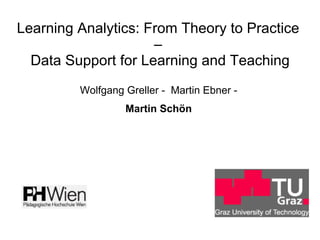
Learning Analytics: From Theory to Practice – Data Support for Learning and Teaching
- 1. Learning Analytics: From Theory to Practice – Data Support for Learning and Teaching Wolfgang Greller - Martin Ebner - Martin Schön
- 2. How we started? At first there was a student who planned to write his thesis about programmng an application for training the multiplication tables. We told him to imagine an ideal teacher, who doesn't know anything about a child. He was only told that he should test the students ability to solve all 90 problems of the tables from 1x1 to 9x10. Please check, that we don´t speak about underlying dispostions! In our schools the pupils learn the multiplication facts. After this they learn addition and subtraction with multi digit numbers. Then they begin to learn the multidigit multiplication and division. When I went to school, our math lessions startet with 10 minutes mental arithmetic over all this periods. Nowadays the teachers don´t like this kind of instruction. But it should be done!
- 3. Along a simple feedback model with pedagogical tasks and intentions and optimized reactions to the students behaviour • the system should estimate the competence grade of the learner • the system should provide appropriate tasks or categories of tasks according to the competence grade of the learner. • the tasks should tend to be challenging. • the system should ensure that already well-done exercises are repeated and practiced. After succeeding a problem the probability for a repeated display should decrease in two levels • the tasks should be delivered on different platforms
- 4. Prototype: Remark: Our University is not defined to support this development. The progress of this project is basec on many fortunate circumstances: First single very engaged students – some funding.
- 5. Now: Ø The matrix at the left shows the history in this training: The beige colour indicates “well known” results, the brown is “one right answer”. The rabbit comes from left to right to the carrot and catches one - if the pupil produces consecutive right answers. The task is shown for one minute.
- 6. Indvidual – class statistics (green, yellow, red lights)
- 8. Some results made us rethink ...
- 9. Classified as 2 id156 0 2 4 6 8 10 1 11 21 31 41 51 61 71 81 91 101 111 121 131 141 151 161 171 181 191 201 211 Then we discovered, that our „diagnostic tool“ helped the students to improve their competences:
- 12. " It is as easy as never before to collect data and to get statistical prove for assumptions about teaching and learning " We perceive much more details about the learners – the learning process – as never before!! There are two separate aspects: the single students and the generation of hypothesis " Teacher get precise information to manage their courses – without additional work. These informations generated by the systems are more precise than a natural person could get. " Results can be used as a formative and a summative asessment – but with much more reliability than single tests → usefulness of the comparative studies
- 13. " The applications take an assessment and a training perspective " The students can work in a formal class situation and alone at home. " We have no opinion about correct interventions
- 14. Questions " We have a situation, where the pupils in a typical class vary more (language, cultural and social background, knowledge). The teacher role is more and more changing form delivering content to facilitate learning. In this sight we expected more willingness to adopt our support tools for teacher interventions. Should we acquire institutions for private teaching?
